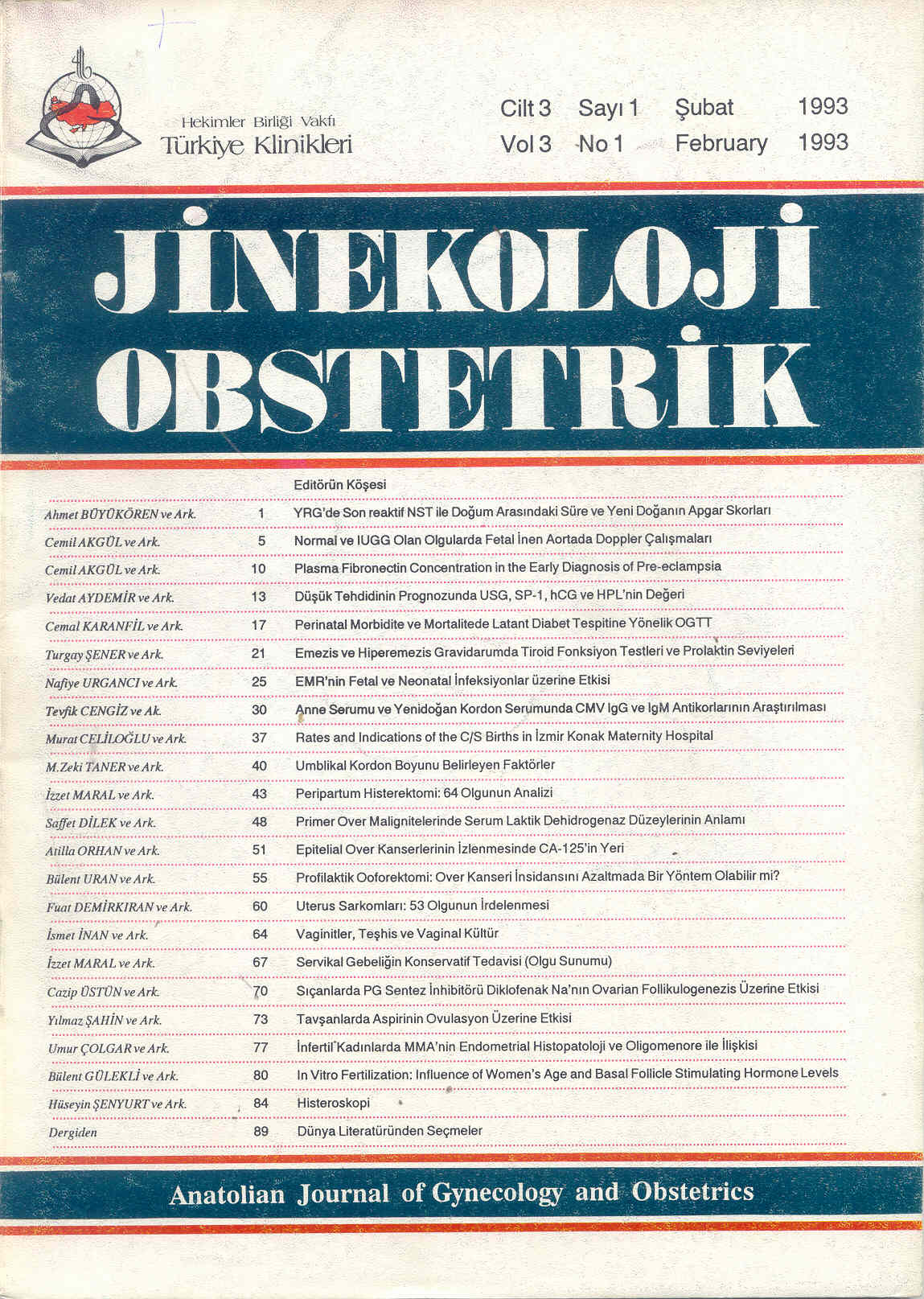Open Access
Peer Reviewed
ARTICLES
3012 Viewed1016 Downloaded
The Neonatal Apgar Scores And The Period Between The Last Reactive Nonstress Test And Birth, In High Risk Pregnancies
Yüksek Riskli Gebelerde Son Reaktif Nonstress Test ile Doğum Arasındaki Süre ve Yeni Doğanın Apgar SkorlarıYüksek Riskli Gebelerde Son Reaktif Nonstress Test ile Doğum Arasındaki Süre ve Yeni Doğanın Apgar Skorları
Turkiye Klinikleri J Gynecol Obst. 1993;3(1):1-4
Article Language: TR
Copyright Ⓒ 2025 by Türkiye Klinikleri. This is an open access article under the CC BY-NC-ND license (http://creativecommons.org/licenses/by-nc-nd/4.0/)
ÖZET
Yüksek riskli gebelik nedeniyle nonstress test ile takip edilen 36 gebelik haftasını tamamlamış 65 gebe çalışmamıza dahil edildi. Son reaktif nonstres ile doğum arasındaki süre, 24 saatin altında. 24-48 saat arası, 48-72 saat arası ve 72 saat-7 gün arası olmak üzere gruplara ayrıldı. Bu gebelerde yeni doğanın 1. dakika apgar skorları retrospektif olarak tespit edildi. Son reaktif nonstres test ile doğum arasındaki süre 24 saatin altında olan 16 gebenin 15'inde (%94), yenidoğanın 1. dakika apgar skoru 8-10 arasında idi. Son reaktif nonstres test ile doğum arasındaki süre 48-72 saat olan 15 gebenin 14'ünde (%93). Yeni doğanın apgar skoru 8-10 arasında idi. Son reaktif nonstres test ile doğum arasındaki süre 72 saat-7 gün arasında olan 21 gebenin 18'inde (%86), yeni doğanın 1. dakika apagr skoru 8-10 arasında bulundu. Bulunan bu değerler ışığında, yüksek riskli gebelerde son reaktif nonstres test ile doğum arasındaki süre 7 günün altında ne olursa olsun yeni doğanın 1. dakika apgar skorunun düşük olma şansının çok az olduğu sonucuna vardık.
Yüksek riskli gebelik nedeniyle nonstress test ile takip edilen 36 gebelik haftasını tamamlamış 65 gebe çalışmamıza dahil edildi. Son reaktif nonstres ile doğum arasındaki süre, 24 saatin altında. 24-48 saat arası, 48-72 saat arası ve 72 saat-7 gün arası olmak üzere gruplara ayrıldı. Bu gebelerde yeni doğanın 1. dakika apgar skorları retrospektif olarak tespit edildi. Son reaktif nonstres test ile doğum arasındaki süre 24 saatin altında olan 16 gebenin 15'inde (%94), yenidoğanın 1. dakika apgar skoru 8-10 arasında idi. Son reaktif nonstres test ile doğum arasındaki süre 48-72 saat olan 15 gebenin 14'ünde (%93). Yeni doğanın apgar skoru 8-10 arasında idi. Son reaktif nonstres test ile doğum arasındaki süre 72 saat-7 gün arasında olan 21 gebenin 18'inde (%86), yeni doğanın 1. dakika apagr skoru 8-10 arasında bulundu. Bulunan bu değerler ışığında, yüksek riskli gebelerde son reaktif nonstres test ile doğum arasındaki süre 7 günün altında ne olursa olsun yeni doğanın 1. dakika apgar skorunun düşük olma şansının çok az olduğu sonucuna vardık.
ANAHTAR KELİMELER: Reaktif nonstres test, Apgar skoru, yüksek riskli gebelik
ABSTRACT
65 pregnant women with high risk pregnancies who have completed 36 weeks of pregnancy and then followed by the nonstress tests were included in our study. With respect to the period between the time of birth and the last reactive nonstress test, they were grouped as the cases with less than 24 hours, 24-48 hours, 48-72 hours and 72 hours-7 days. In these pregnancies first minute apgar scores were evaluated retrospectively. In the 15 of 16 pregnancies (94%) who had shorter then 24 hours period between the last reactive nonstress test and birth, first minute apgar scores were between eight to ten. Eleven of 13 (85%) pregnancies who had 24-48 hours period between last nonstress test and birth, the first minute apgar scores were between eight to ten. 14 of 15 (93%) pregnancies who had 48-72 hours between the last reactive nonstress test and birth, the neonatal first minute apgar scores were between eight to ten. In 18 of 21 (86%) pregnancies who had 72 hours-7 days between the last reactive nonstress test and birth, the neonatal first minute apgar scores were eight to ten. According to these evaluations, in high risk pregnancies, we concluded that the changes of obtaining low apgar scores in cases which has less than seven days period between the last reactive nonstress test and the birth is very low.
65 pregnant women with high risk pregnancies who have completed 36 weeks of pregnancy and then followed by the nonstress tests were included in our study. With respect to the period between the time of birth and the last reactive nonstress test, they were grouped as the cases with less than 24 hours, 24-48 hours, 48-72 hours and 72 hours-7 days. In these pregnancies first minute apgar scores were evaluated retrospectively. In the 15 of 16 pregnancies (94%) who had shorter then 24 hours period between the last reactive nonstress test and birth, first minute apgar scores were between eight to ten. Eleven of 13 (85%) pregnancies who had 24-48 hours period between last nonstress test and birth, the first minute apgar scores were between eight to ten. 14 of 15 (93%) pregnancies who had 48-72 hours between the last reactive nonstress test and birth, the neonatal first minute apgar scores were between eight to ten. In 18 of 21 (86%) pregnancies who had 72 hours-7 days between the last reactive nonstress test and birth, the neonatal first minute apgar scores were eight to ten. According to these evaluations, in high risk pregnancies, we concluded that the changes of obtaining low apgar scores in cases which has less than seven days period between the last reactive nonstress test and the birth is very low.
MENU
POPULAR ARTICLES
MOST DOWNLOADED ARTICLES





This journal is licensed under a Creative Commons Attribution-NonCommercial-NoDerivatives 4.0 International License.










